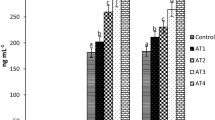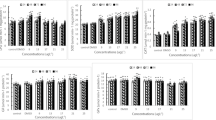Abstract
Exposure of the tropical arcid blood clam Anadara granosa L., collected from Bombay waters in 1986, to sublethal concentrations of naphthalene (Nap) (5, 10 and 15μg Nap ml-1), induced various changes in vital biochemical systems. The condition index (CI) remained largely within the control range, although tissue water content after 96h exposure increased significantly (p<0.001). Glycogen levels appreciably decreased, both in muscles (p<0.001) and digestive glands (p<0.01). AMP activity remained unaltered irrespective of the ambient Nap concentration. ADP levels decreased by more than 20% and ATP levels also decreased significantly (p≪0.001) by more than 60% with increases in ambient Nap levels from 5 to 15 μg ml-1. Lysosomal marker enzymes-arylsulphatase and acid phosphatase-showed various changes. Levels of the former were 10 to 17 times higher than the latter. Total and free arylsulphatase activity in hepatic cells decreased on exposure of clams to 5 and 10μg Nap ml-1, but not significantly. However, it was significantly inhibited (p<0.001) towards the upper limits of exposure concentration. The same was also true of acid phosphatase activity. Nicotinamide adenine dinucleotide (NADH2) oxidation of lipochrome showed a dramatic decrease in activity in the range of 37 to 88% over controls with increasing Nap from 5 to 15 μg ml-1. Fatty acids also exhibited significant changes in composition with a decrease in polyunsaturated acids and an increase in certain saturated fatty acids. Protein and carbohydrate levels increased significantly (p<0.001) towards upper limits of exposure concentration. Pyruvic acid levels increased significantly by 2 to 6 times over controls on exposure to 5 to 15 μg Nap ml-1. Explanation of these changes is attempted in terms of the glycolysis pathway involving pyruvic acid oxidation and oxidative phosphorylation in the electron transport system.
Similar content being viewed by others
Literature cited
Abel, P. D. (1976). Effect of some pollutants on the filtration rate of Mytilus. Mar. Pollut. Bull. 7: 228–231
Anderson, J. W. (1979). An assessment of knowledge concerning the fate and effects of hydrocarbons in the marine environment. In: Vernberg, W. B., Calabrese, A., Thurberg, F. P., Vernberg, F. J. (eds.) Marine pollution: functional responses. Academic Press, New York, p. 3–22
Atkinson, D. E. (1977). Cellular energy metabolism and its regulation. Academic Press, New York
Barthel, D. (1984). Adenylate energy charge in three marine bivalve species during anoxia. Ophelia 23: 155–164
Capuzzo, J. M., Lancaster, B. A. (1981). Physiological effects of south Louisiana crude oil on larvae of the american oyster (Homarus americanus). In: Vernberg, F. J., Calabrese, A., Thurberg, F. P., Vernberg, W. B. (eds.) Biological monitoring of marine pollutants. Academic Press, New York, p. 405–423
Dange, A. D. (1986). Changes in carbohydrate metabolism in Tilapia oreochromis (Sarotherodon) mossambicus during short term exposure to different types of pollutants. Envir. Pollut. 41: 165–177
Deutsch, A., Nilsson, R. (1953). Ion exchange chromatography of adenosine phosphatase. Acta. chem. scand. 7: 1288–1292
De Zwaan, A., Zandee, D. I. (1972). The utilization of glycogen and accumulation of some intermediates during anaerobiosis in Mytilus edulis (L). Comp. Biochem. Physiol. 43B: 47–54
Din, Z. B., Brooks, J. M.: (1986). Use of adenylate energy charge as physiological indicator in toxicity experiments. Bull. envir. contam. Toxic. 36: 1–8
Dunning, A., Major, C. W. (1974). The effect of cold seawater extracts of oil fractions upon the blue mussel. Mytilus edulis. In: Vernberg, F. J., Vernberg, W. B. (eds.) Pollution and physiology of marine organisms. Academic Press, New York, p. 349–366
Eapen, J. T., Patel, B. (1989). Haematological evaluation of naphthalene intoxication in the tropical arcid blood clam Anadara granosa. Mar. Biol. 100: 223–226
Friedmann, T. E., Hangen, G. E. (1943). Pyruvic acid. II. The determination of keto acids in blood and urine. J. biol. Chem. 147: 415–442
Gilfillan, E. S. (1973). Effect of seawater extracts of crude oil on carbon budgets in two species of mussels. In: Proc. Conf. Prev. Control of Oil Spills 1973: 691–695
Gilfillan, E. S. (1975). Decrease of net carbon flux in two species of mussels caused by extracts of crude oil. Mar. Biol. 29: 53–57
Haya, K., Waiwood, B. A. (1983). Adenylate energy charge and ATPase activity: potential biochemical indicators of sublethal effects caused by pollutants in aquatic animals. In: Narigu, J. O. (ed.) Aquatic toxicology. John Wiely & Sons, New York, p. 307–333
Ivanovici, A. M. (1980). Adenylate energy charge: an evaluation of the applicability to assessment of pollution effects and directions for future research. Rapp. P.-v. Réun. Cons. perm. int. Explor. Mer. 179: 23–28
Kluytmans, J. H., de Bont, A. M. T., Janus, J., Wijsman, T. C. M.: (1977). Time dependent changes and tissue specificities in the accumulation of anaerobic fermentation products in the sea mussel Mytilus edulis L. Comp. Biochem. Physiol. 58B 81–87
Kluytmans, J. H., Van Graft, M., Janus, J., Pieters, H. (1978). Production and excretion of volatile fatty acids in the sea mussel Mytilus edulis L. J. comp. (Sect. A) Physiol. 123: 163–167
Lal, B., Sing, A., Kumari, A., Singh, N. (1986). Biochemical and hematological changes following malathion treatment in the freshwater cat fish Heteropneustes fossilis (Bloch). Envir. Pllut. (Ser. A) 42: 151–156
Lowry, O. H., Rosebrough, A. L., Farr, A. L., Randall, R. J. (1951). Protein measurement with Folin-phenol reagent. J. biol. Chem. 193: 265–275
Middleditch, B. S., Missler, S. R., Hines, H. B., McVey, J. P., Brown, A., Ward, D. G., Lawrence, A. L. (1980). Metabolic profiles of penaeid shrimp: dietary lipids and ovarian maturation. J. Chromat. 195: 359–368
Neff, J. M. (1979). Polycyclic aromatic hydrocarbons in the aquatic environment. Applied Science Publications, England
Oudejans, R. C. H., Van der Horst, D. J. (1974). Aerobic-anaerobic biosynthesis of fatty acids and other lipids from glycolytic intermediates in pulmonate land snail, Cepaea nemoralis (L). Comp. Biochem. Physiol. 43: 139–147
Patel, S., Patel, B. (1985). Effect of environmental parameters on lysosomal marker enzymes in the tropical blood clam Anadara granosa. Mar. Biol. 85: 245–252
Romano, J. C., Daumas, R. (1981). Adenosine nucleotide energy charge ratios as ecolphysiological index for microplankton communities. Mar. Biol. 62: 281–296
Seifter, S., Dayton, S., Novic, B., Muntwyler, E. (1950). Estimation of glycogen with anthrone reagent. Arch. Biochem. 25: 191–200
Silbergeld, E. K. (1974). Blood glucose: a sensitive indicator of environmental stress in fish. Bull. Environ. Contam. Toxicol. 11: 20–25
Simkiss, K., Taylor, M., Mason, A. Z. (1982). Metal detoxification and bioaccumulation in molluscs. Mar. Biol. Lett. 3: 187–201
Sklar, F. H., McKee, K. L. (1984). Adenylate energy charge (AEC) responses to stress and extraction techniques in the Louisiana swamp cryfish, Procambarus clarkii. Bull. envir. Contam. Toxic. 33: 584–591
Stainken, D. M. (1978). Effects of uptake and discharge of petroleum hydrocarbons on the respiration of the soft-shell clam, Mya arenaria. J. Fish. Res. Bd Can. 35: 637–642
Stekoll, M. S., Clement, L. E., Shaw, D. G. (1980). Sublethal effects of chronic oil exposure on the intertidal clam Macoma balthica. Mar. Biol. 57: 51–60
Sylvestre, C., Le Gal, Y. (1987). In situ measurements of adenylate energy charge and assessment of pollution. Mar. Pollut. Bull. 18: 36–39
Van der Horst, D. J. (1974). In vivo biosynthesis of fatty acids in the pulmonate land snail Cepaea nemoralis (L) under anoxic conditions. Comp. Biochem. Physiol. 47B: 181–187
Varanasi, U., Gmur, D. J., Treseler, P. A. (1979). Influence of time and mode of exposure on biotransformation of napthalene by juvenile starry flounder (Platichthys stellatus) and rock sole (Lepidopsetta bilineata). Archs. envir. Contam. Toxic. 8: 673–692
Zs-Nagy, I. (1977). Cytosomes (yellow pigment granules) of molluscs as cell organelles of anoxic energy production. Int. Ref. Cytol. 49: 331–377
Zs-Nagy, I., Ermini, M. (1972a). Oxidation of NADH2 by the lipochrome pigment of the tissues of the bivalve Mytilus galloprovincialis (Mollusca, Pelecypoda). Comp. Biochem. Physiol. 43B: 39–46
Zs-Nagy, I., Ermini, M. (1972b). ATP production in the tissues of the bivalve Mytilus galloprovincialis (Pelecypoda) under normal and anoxic conditions. Comp. Biochem. Physiol. 43B: 593–600
Zurberg, W., Kluytmans, J. H. (1980). Organ specific changes in energy metabolism due to anaerobiosis in the sea mussel Mytilus edulis (L). Comp. Biochem. Physiol. 67B: 317–322
Author information
Authors and Affiliations
Additional information
Communicated by O. Kinne, Oldendorf/Luhe
Rights and permissions
About this article
Cite this article
Patel, B., Eapen, J.T. Biochemical evaluation of naphthalene intoxication in the tropical acrid blood clam Anadara granosa . Mar. Biol. 103, 203–209 (1989). https://doi.org/10.1007/BF00543348
Accepted:
Issue Date:
DOI: https://doi.org/10.1007/BF00543348




